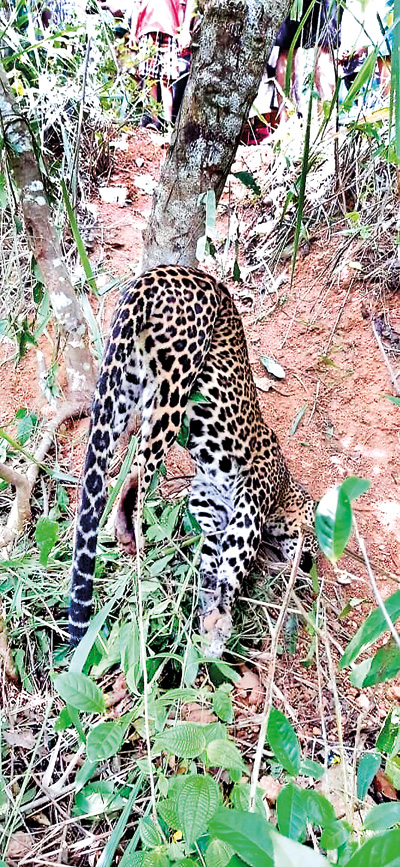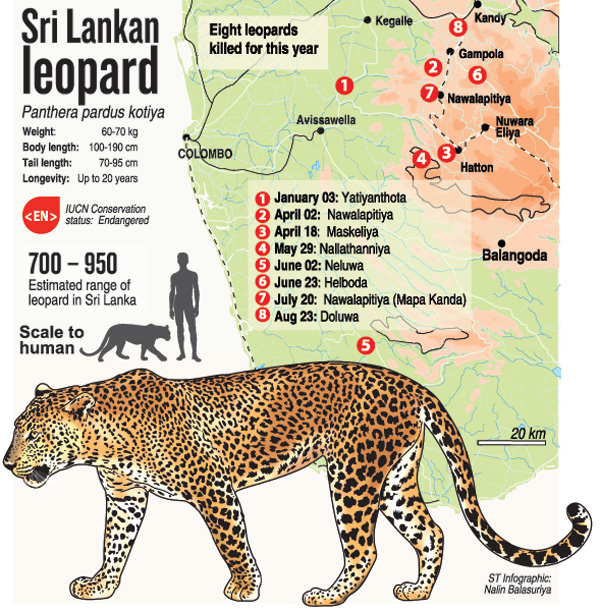News
Animals die while DWC’s 16 vets try to cover the country
It took time for wildlife rangers in Nuwara Eliya, 65km away, to come to Gampola and capture a roaming leopard that had sent the area into panic; by the time the rangers arrived, someone else had acted and the leopard was dead, illegally trapped in a snare.

The leopard that was found dead in a snare last Sunday
The Assistant Principal of Zahira College in Gampola, T.M.S. Moovie, said parents and teachers had been terrified for the safety of students after reports of a leopard in the area had spread. He said leopards and fishing cats had been sighted frequently in woodland on the hill behind the school.
Students had been banned from going outside classrooms and staff and security guards patrolled the premises.
“The vigil for leopards almost turned into a military operation,” Mr. Moovie said. The wildlife and forestry departments, police, local council and local education office had been asked for help.
Fears intensified when the partially-eaten heads of two dogs were found early last week in an area where the leopard had been seen. The Gampola Divisional Secretariat advised people to stay indoors.
The leopard was found dead last Sunday in a snare set on a tract of privately-owned land adjoining the school. This was the seventh leopard death in snares, the other recent cases reported in Yatiyantota, Nawalapitiya, Maskeliya, Nallathanniya, Neluwa, Helboda and Nawalapitiya.
Divisional Secretary Thushari Tennekoon urged the need for a wildlife office in Gampola, saying that even though the rangers in Nuwara Eliya had responded to calls for help they had arrived too late as they had to make an 65km journey.
“Wildlife officers need to act quickly,” Ms. Tennekoon said. “When they get late people take matters into their own hands, and as a result those endemic animals are killed.
“We suspect that the people in the area set the snare as they were concerned for the safety of the schoolchildren.”
Leopards wander freely in uninhabited private land running between forest and populated areas, Ms. Tennekoon said.
Police are looking for the person or group responsible for the snare.
“We asked residents to stay indoors and not venture out in search of the leopard. We also asked them to not cause harm to the animals and wait for the arrival of wildlife officers,” Gampola Chief Inspector Sampath Wickremaratne said.
“Leopards are endangered and protected, so we will take legal action if we catch the person responsible.”
A wildlife ranger pointed out a fundamental problem in dealing with situations of this kind.
“There are only 16 veterinary surgeons attached to the Department of Wildlife Conservation (DWC). By the time we try to get one the animal is either dead or seriously injured. Even when we try to get a private veterinary surgeon to the area where the animal is found it’s too late,” the ranger said.
The officer said there was an urgent need to have more wildlife offices, at least one in every divisional secretariat in areas where human-animal conflicts occur, and a specially trained vet attached to each office or at least rangers who have received some veterinary training.
Saving leopards required training, equipment and veterinary knowledge. Rangers in other countries were trained to administer tranquillisers shot from dart guns and were given basic training to treat animals but local wildlife officers lacked these advantages.
When, unequipped and untrained, these officers tried to handle leopards caught in snares they were often unable to get close to the animal for fear the furious leopard would struggle and harm itself or harm rangers. 
The Director of Wildlife Health, Dr. G.A. Tharaka Prasad, admitted that having 16 veterinary surgeons in the wildlife department was inadequate. The vet stationed at Randenigala was in charge of treating animals across a wide range including Nuwara Eliya, Mahiyanganaya and Matale, he added.
The department was attempting to appoint 10 more vets to cover relief duties since the current 16 doctors had no relief officers.
Dr. Prasad said young vets, when they qualify, avoid joining the wildlife department as they had to work under difficult conditions for fixed pay.
“Veterinary surgeons working for the wildlife department have to work long hours, carry out on-the-spot treatment on unpredictable wild animals and travel in difficult terrain,” he said.
Young veterinarians found it more profitable to enter private practice and complain that the department lacked a grading system to enable promotions, Dr. Prasad said.
He said vets currently on the department’s staff are being offered sweeteners to stay, with firearms, medical equipment, surgeries and staff on offer.
“The department spends a lot on maintaining veterinarians as they are valuable in the field,” Dr. Prasad said.
Plans are in train to set up an office in Gampola.
DWC Director-General Chandana Sooriyabandara said Gampola was notorious for the high number of leopards killed in snares and rangers had been instructed to mount special operations in the area to find and remove snares on estates and in abandoned private land.
“We understand the need for a wildlife range office dedicated to leopard conservation and have planned to acquire a state-owned building in the Maawatura area for this purpose, Dr. Sooriyabandara said. A dedicated team of wildlife officers would be formed to quickly respond when leopards are found caught in snares.
He said it was difficult to hunt down those responsible for setting snares. “The areas where snares are often set are abandoned private property where any person can erect snares with no fear of witnesses. If we find evidence we take action but most times it is nearly impossible to pinpoint culprits,” he said
The DWC planned to increase its strength to 3,500 wildlife officers and rangers, Dr. Sooriyabandara said.
| Fierce predator helpless in a tangle of steel | |
| Sri Lanka’s largest predator reigns supreme at the top of the food chain, able to drag prey twice its weight up a tree to be eaten at leisure – but it is helpless when caught in a snare, meeting an agonising death as the wires tighten around it with every convulsion as it struggles to escape. The leopard (Panthera pardus kotiya) often suffers Capture Myopathy when caught in snares, the Department of Wildlife Conservation’s Director of Wildlife Health, Dr. Tharaka Prasad said: while animals naturally strive to flee from predators they are not adapted to struggle for long periods as they do when caught in snares, and when they do so their physical structure degenerates. They might develop severe muscle damage from the over-exertion and suddenly die, and even if they are freed or manage to escape they experience weakness, tremors, loss of coordination and depression. Dr. Prasad said their frail condition would often cause them to become entangled in trees or bushes and die. “The part of the body that is caught in the snare determines the plight of the animal,” Dr. Prasad said. “If it is the lumbar or mid-section that is caught in the wire of the snare, the blood supply to kidneys is reduced, causing renal failure. If a leopard is suspended head down the animal would have difficulty breathing as their diaphragm movement is obstructed,” he explained. He urged people not to go close to a leopard if they discover one caught in a snare as the frightened animal would struggle even harder to escape, exhausting itself and worsening its injuries. |

